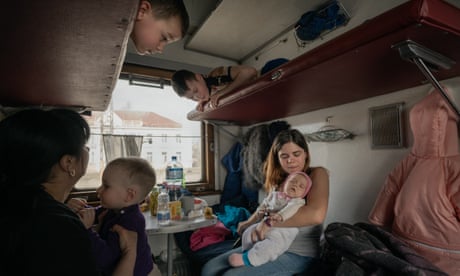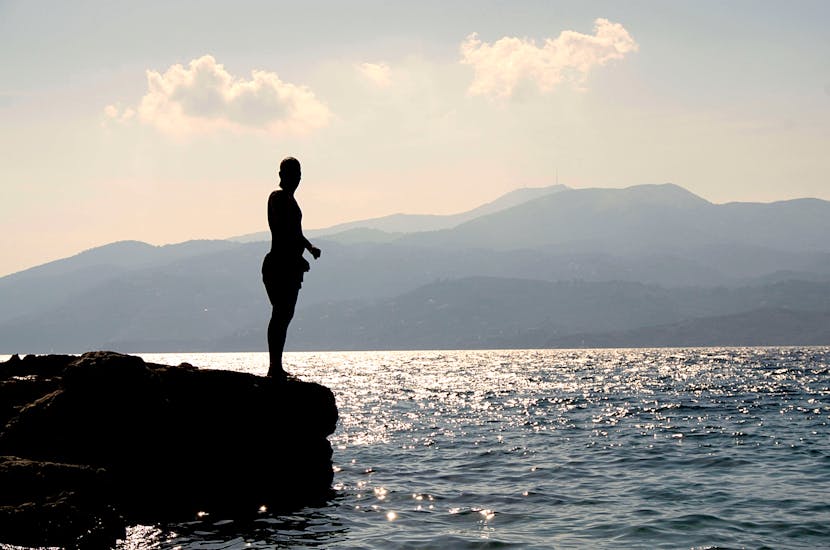- by foxnews
- 06 Mar 2025
The people who keep the refugee trains running out of Ukraine - photo essay
The people who keep the refugee trains running out of Ukraine - photo essay
- by theguardian
- 01 Apr 2022
- in news

Windows shuttered and lights dimmed, a darkened train pulls into a station platform, also unlit. As the train comes to a halt, carriage attendants toss boxes of humanitarian aid to station workers waiting on the platform.
Huddles of passengers, who arrived at the station hours earlier so as not to be on the streets during curfew hours, search in the inky blackness for the right carriage, before the train is on its way again with a gnashing of wheels and a long hiss of steam.
This scene has played out at stations across Ukraine repeatedly over the last month, as Ukrainian Railways has been engaged in one of the most impressive elements of Ukraine's war effort. Several million people have travelled west to safety on evacuation trains, while the carriages have returned east packed with tonnes of humanitarian aid.
Ukrainian Railways employs more than 230,000 people, and almost all its employees have stayed in the country to work, according to Oleksandr Kamyshin, the company's CEO. While stations in the areas under Russian occupation are now closed, the trains have continued running even to cities like Kharkiv, which has been under constant Russian fire.
Since the war started 64 employees have died and 71 have been injured, he said, counting incidents at work and those at the homes of employees.
"If the track is blown up, we repair it. If we can get somewhere, we go. It may be dangerous for our staff, but then that train can save thousands of other people from danger," said Kamyshin, in an interview at Kyiv's central station. He and a small "mobile command centre" of seven people has spent the last month crisscrossing the country on trains, to show support for staff working in all parts of the country.
"We have several special carriages for our use, but we don't use them outside the west of the country because the Russians may be able to identify them," he said.
At the peak of the evacuation programme, 200,000 people a day were travelling west, on trains that were made free of charge for everyone, with women and children having priority.
There were heartbreaking scenes at Kyiv's central station during the early part of the war, as residents feared the capital could face the same fate as Mariupol, Kharkiv and other cities and scrambled to get out as quickly as possible. The trains were often crowded, uncomfortable and sweaty inside, but they did the job. In the first two weeks of the war alone, 2 million passengers were taken to safety.
Dmytro Yaroshenko, 36, has been working on the railway since he was 20. He is now the train manager on the 82 train, running between Uzhhorod in the far west, on the Slovakian border, and Kyiv.
"We turn the lights off for the section of the journey around Kyiv, and anywhere that might be dangerous, as well as if the train stops. Who knows who might be hiding in the bushes," he said, on a recent journey towards the Ukrainian capital.
He said he had no qualms about continuing to work during wartime, and saw his own role as part of the overall Ukrainian war effort.
"It's painful that our soldiers, our women and children are dying. But nerves and hysterics don't help. At these times it's better to get a grip of yourself and stay calm," he said.
Working the trains is a way of life in Ukraine, and Yaroshenko talks about his team with genuine pride. The number 82 is "one of the best" in the country, he said. He wore a smart navy uniform with gold buttons embossed with the Ukrainian trident.
"I have 25 carriage attendants, and we're like a family. We have New Year's parties together, we have our own group on Viber. They need to look at their boss and take an example from me that I'm not panicking," he said. On his days off, he helps guard a checkpoint near his home village.
The train manager is responsible for ensuring the safety of the journey and the passengers, a role which has taken on added meaning in wartime. Before each departure, Yaroshenko checks various WhatsApp and Telegram groups where train operators share the latest intelligence. Last Thursday, he was alarmed by reports that a train had come under fire near the town of Vasylkiv outside Kyiv, and several windows had been blown out.
It transpired that, in fact, a Russian missile had hit a nearby fuel storage depot, and the shock waves had smashed the windows. The track was undamaged, and Yaroshenko's train could run as scheduled.
As the war has ground on, small things have changed: there is no longer fresh bedding in the sleeping carriages, because some of the places they were laundered are now under Russian occupation.
Almost every train is late arriving, because they stop to load and unload humanitarian aid, and have to wait outside large cities if air raid alerts are sounding when they are due to pull in. Their top speeds have been reduced, so that in the case of sabotage, accidents would be less likely to be fatal.
But, remarkably, most trains continue to run.
In recent years, Ukrainian Railways has undergone a programme of significant reforms, and installed a young, western-educated management team. Kamyshin is just 37. However, he said the necessities of war period had forced him to return to some of the old ways.
"We had implemented European stuff and became a place of discussions rather than decisions, we lost this vertical command culture. In wartime, we brought it back," he said, adding that some of this speedy decision making would be retained after the war was over.
Kamyshin said the evacuation programme is now "basically done", and the focus of the railway leadership is now on helping to build export and customs capacity on the country's western borders to increase rail exports, after the Russian advance has put Ukraine's southern ports, which handle much of its export trade, out of action.
"Once the ports are unblocked the cargo will flow through them again, but we will still have this crazy neighbour. And this crazy neighbour could make problems for years. So we need to develop these western corridors, and have them as Plan B, with the option to extend them significantly at any moment."
- by travelandtourworld
- descember 09, 2016
Albania Bans TikTok for One Year Over Youth Safety Concerns Amid Growing Social Media Scrutiny
Albania has officially announced a year-long ban on TikTok, becoming the latest country to take action against the social media platform amid concerns over youth safety and digital security. The decision, revealed by Education Minister Ogerta Manastirliu, comes as part of broader efforts to regulate online content and minimize the platform’s perceived negative influence on young users.
read more


